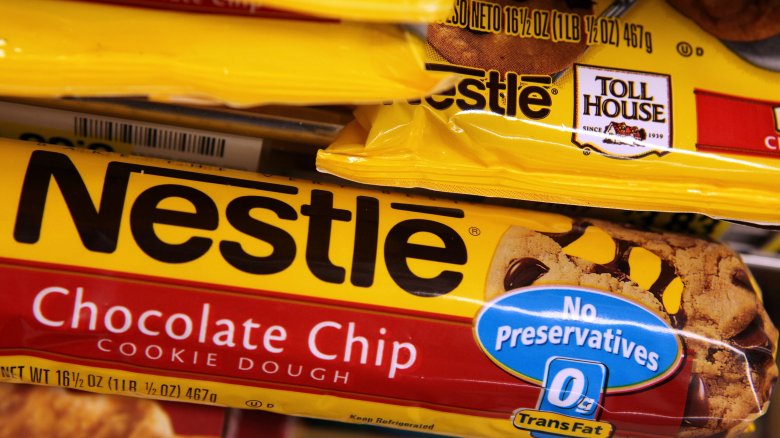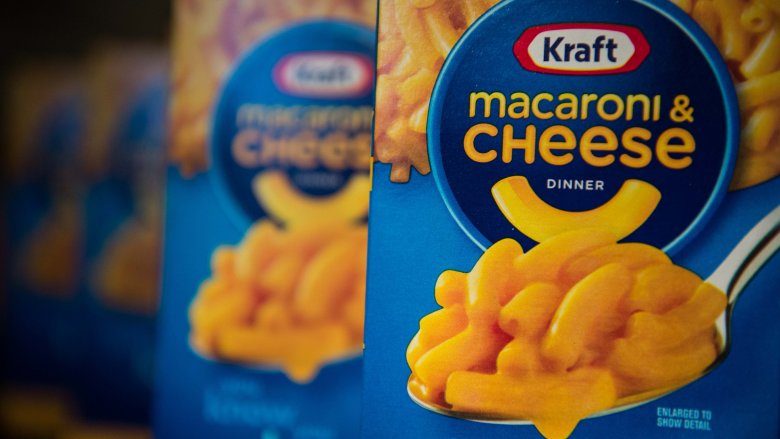Foods That Secretly Changed Their Ingredients
Consistency is definitely key when it comes to the foods you love, whether you're making your family's favorite dinner, going out to grab a slice of your favorite pizza, or opening a jar of goodness you picked up at the grocery store. That's why you stick with your favorite brands and flavors, right? So it's no surprise that even a minor change to a tried-and-true favorite can cause some serious uproar among loyal customers.
It's bad enough when companies announce the changes, but they don't always make a grand announcement. Sometimes, the changes happen under the radar, and sometimes the company takes great strides to keep them that way. You might not even notice they made a change — or maybe you did notice something's different but you can't quite put your finger on what it is.
Did you know these foods changed their recipes on the down-low? You might not have, even if they're your favorites.
Nestle's Chocolate Chips
In 2015, social media got pretty accusatory toward Nestle. Consumers were complaining their Toll House cookies weren't coming out as scrumptious as they usually were, and we all know you don't mess with someone's chocolate chip cookies. Nestle gave all kinds of reasons why there might suddenly be a change in cookie quality for some, and that included things like a temperature or moisture change. They claimed there wasn't anything different in their recipe, but Delish pointed out the complaints came on the heels of an announcement affirming Nestle's commitment to phasing out artificial flavors and ingredients.
They claimed those changes would only effect certain candies and not their Tollhouse baking morsels, but we do know there was just such a change made, way back in 2009. Artificial vanillin was replaced with real vanilla in the semi-sweet chips. The same change happened to the milk chocolate chips in 2015. Does this have something to do with it? Nestle says no, but the bakers of the internet tend to disagree.
Taco Bell's cheese
There's a weird thing that happened when we started adding bright, unnatural colors to cheese: somehow, it just tasted better. But eventually, we started growing more and more concerned about those colors — and what exactly made them so bright (obviously nothing in nature). So in 2015, those concerns led Taco Bell to promise they were going to remove artificial ingredients — especially colors — from their food.
If you've stopped at Taco Bell for some nachos or fries lately, you may have noticed the cheese looked a little funny (or maybe not, because who really studies their fast food, anyway?). That's because they're no longer using Yellow No. 6, the artificial color that's always given it that bright yellow hue that looks like it should glow in the dark. According to Time, a few other menu items were impacted, too, including their seasoned beef. Co-branded items, like their Doritos-flavored taco shells, will remain artificially-colored and unnaturally bright, at least for now.
Fanta
Fanta is the brightly-colored soda with World War II roots, and it's been the subject of a number of changes over the years. Atlas Obscura says it was originally made from ingredients left over from processing fruit, cheese, and bread in Nazi-era Germany, and we can all be glad that entire era has passed.
The more recent change that happened somewhere around 2017 was less noticeable, and we only found out about it when incoming Coca-Cola CEO James Quincey talked to Bloomberg Businessweek about how he was planning on reaching a new generation of consumers who weren't too keen on sugar. He mentioned it almost as an aside in mid-interview, saying they had quietly removed a large percentage of the sugar from both Fanta and Sprite. It was a test (in Europe and Australia, respectively) that also shaved 30 percent of the calories off Fanta. Why would you keep that a secret?
There's no word on whether or not the changes will happen in the U.S., but if history is any indication, they won't tell us anyway.
Nutella
Some days just call for coming home and snacking on a massive spoonful of Nutella right out of the jar, and there's nothing wrong with that. It's possible you didn't notice that creamy chocolate spread has actually changed, through, as it took The Hamburg Consumer Protection Centre to noticed a change to Nutella's labels in November 2017. They were looking at a European version (via The Telegraph) that has more skimmed milk and sugar than before. Ferrero claimed there was no taste or nutritional difference, but social media wasn't buying it.
Even stranger, Nutella did something a bit different with their US products. Stateside, consumers picking up a jar post-2017 are getting a spread that's swapped a bit of milk powder for whey powder. According to their official explanation (via Time), they did it so they can more accurately control the quality of the milk products they use. Social media exploded on both sides of the Atlantic once news got out, and to say people were mad is an understatement.
Kraft Mac & Cheese
No one's going to say there's anything natural-looking about Kraft Macaroni & Cheese, but everyone can agree it's the stuff of Sunday afternoons, late-night snacking, and lunches for those in the college crowd. It has a lot of powerful associations for a lot of people, and that makes it even more surprising that absolutely no one noticed when it changed. In March 2016, CNN reported that Kraft had come clean and announced the change... that had actually happened months earlier.
By the time Kraft started talking, they'd already sold around 50 million boxes of mac and cheese with the new recipe, without a peep from consumers. So, what changed? In April 2015, Kraft said it was going to remove artificial ingredients and replace them with more natural ones, then did — without telling anyone. The artificial colors disappeared, and now that bright yellow-orange color comes from things like annatto, paprika, and turmeric instead of Yellow No. 5 and 6. Artificial preservatives and flavors were removed, too, without fanfare for what they called "the world's largest blind taste test."
HP Sauce
HP sauce is a staple in British kitchens and across the globe, and for many it's just as important as the eggs or the bacon in a good breakfast fry-up. You might notice the classic brown sauce is a little different than it used to be, though, and that's because they changed the recipe for the first time after 116 years.
According to The Telegraph, the change came in secret and only after the interference of UK government health officials. They requested the salt content be almost cut in half, and Heinz (the American giant who bought HP Sauce in 2005) says they had to ditch that salt to comply with the guidelines of the Coalition Government's Responsibility Deal, which aims to reduce everyone's overall salt intake, for obvious health reasons. The problem though, is that the new lower-salt formula now includes higher counts of both carbs and calories, and fans say the difference can be tasted. It didn't go over well, with professional chefs like Marco Pierre White condemning the new flavor as "definitely dodgy."
Twinkies
If you remember anything about 2012, you might remember the devastating announcement that Twinkies would be no more. Devastating.
Twinkies were back about eight months later, and people were so psyched that many didn't notice they'd changed. They were 10 percent smaller, according to Medical Daily, and had fewer calories and a longer shelf life. That's extra-odd, given that Twinkies already had a reputation as being one of the few things that would probably survive a nuclear apocalypse. (They actually won't.)
So, what gives? NPR says we're not exactly sure, and that's because the recipe is top secret. Only basic ingredients have been made public for both the sponge and the creme filling, and they're not saying what's changed to increase shelf life. We can tell you, though, that they've been through an even bigger recipe change once before. Before World War II, they were banana-flavored. Bananas were rationed, a replacement flavor was needed, and vanilla Twinkies were born (via Business Insider).
Breyers
Next time you grab a carton of Breyers ice cream, check the label. You might be surprised to find that some flavors aren't officially ice cream anymore.
They're "frozen dairy desserts," and the change impacted popular flavors like chocolate chip cookie dough and rocky road, says CBS. (They also add Breyers isn't the only company to do this, they're just the ones that did it across most flavors.) When they did a blind taste test, people couldn't tell the difference. Side by side with real ice cream, though, there was a huge difference.
Breyers is a little secretive about just what the change is, but they do say on their FAQ that the frozen dairy dessert products don't meet the legal definition for ice cream because they're not less than 10 percent dairy fat. They do say they use all the same basic ingredients to make a product with a smoother texture, but it's definitely not ice cream anymore.
Fast food fries
French fries are delicious little sticks of goodness, but they're not the healthiest things in the world. That's no secret, but it turns out that McDonald's — and other fast food joints — have been keeping a major secret about their fries for decades.
It was a Canadian journalist named Malcolm Gladwell who decided to try to find out why the fries of his memory were so much better than the fries of today, and he discovered that on July 23, 1990, McDonald's secretly changed their recipe. It started with Phil Sokolof, an American who went on an anti-cholesterol crusade after having a heart attack when he was only 43. His campaign included spending millions taking out ads attacking fast food fries for being unhealthy, and he ended up doing so much damage that chains buckled. Beef tallow had been a staple fry oil for a long time, and McDonald's, Burger King, and Wendy's all switched to other oils. Unfortunately, those other oils weren't actually any healthier, and they were definitely less tasty. Bummer.
McDonald's soft serve
It's definitely not ice cream, but it fills the void whenever we're hit with a craving for something soft, sweet, and chilly. If you've stopped at McDonald's for a soft serve cone or a McFlurry lately, you probably didn't even realize you're getting something new and different. According to Nation's Restaurant News, most people didn't notice.
Around 60 percent of McDonald's desserts were changed in 2017, with the company's promise to get rid of artificial ingredients. Soft serve lost preservatives, colors, and artificial flavors, and by the time they had announced it, the change had already been implemented for months in most locations. They also did a sneaky recipe change to their strawberry and chocolate shakes, taking out the high fructose corn syrup in a bid to make it a bit more natural. Whipping toppings lost their artificial flavors, and that comes on the heels of more widely publicized changes like stripping artificial ingredients from Chicken McNuggets. Bet you didn't notice that, either.
Lucky Charms
Lucky Charms harkens back to the good old days of cereal, when sugar reigned supreme over boring things like granola. It's been around since 1964, and even if you've been a fan for most of those decades, you may have missed all the changes they made to this childhood favorite.
We are, of course, talking about the most important ingredient: the marshmallows. Foodbeast says they're technically called marbits, and originally, there were green clovers, yellow and orange stars, pink hearts, and yellow moons. They didn't change until 1975, with the addition of the blue diamond and frosted sugar on the more boring, non-marshmallow bits. How many other marshmallows can you name? How about the purple horseshoe, the red balloons, and the green trees? The popular magic rainbow was added in 1993, and over the next few decades there were other shapes that came and went. There was the pot of gold, the blue moon, the shooting star, and the leprechaun's hat.
They're all presenting a huge problem for General Mills. Munchies says they made a public, 2016 promise to get rid of artificial flavors and colors, but it was Lucky Charms' marshmallows that were the biggest challenge.
Papa John's sausage
The real story behind Papa John's is a weird one, and one of the principles they built their business on is using better ingredients to make better pizza. If that sounds pretty vague, it is — and they were once sued over it. But in 2017, Schnatter talked to Business Insider and repeated his commitment to the idea. He also shared the story of how it came about, and it's disturbing.
He opened in 1985, and it wasn't until around 1997 that Schnatter himself visited one of their suppliers to see how their sausage was being made. "I was watching them do things with the sausage I didn't like," he said. "They used the hoof of the cow. They used the face of the cow."
It's not uncommon, and in fact, there's a name for those cuts: head meat. Schnatter says he made a deal with the supplier to create a sausage that didn't have any of those more non-traditional cuts of meat in them, and that was a sneaky, secret ingredient change they definitely didn't publicize.












